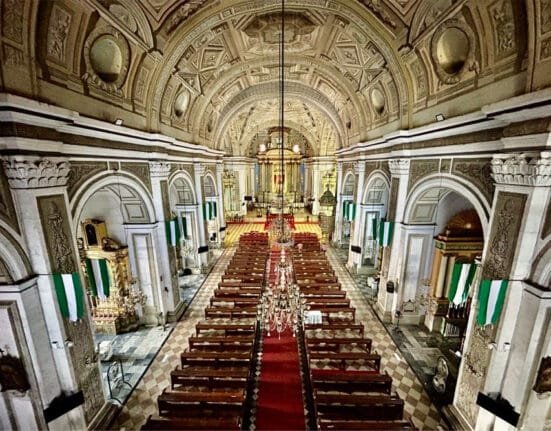THE San Agustin Museum and Cultural Center is one of the oldest surviving museums in the Philippines, and is located inside the walled city of Intramuros.
Adjacent to the 452-year-old San Agustin Church, the country’s oldest church, the San Agustin museum is home to the collection of religious artifacts showcasing the historical roots of Philippine religiosity.
Under the collective serial declaration title Baroque Churches of the Philippines, the United Nations Educational, Scientific, and Cultural Organization (UNESCO) selected the San Agustin Church as one of four Philippine churches built during the Spanish colonial period to be included among the World Heritage Sites in 1993.
Sala Recibidor
When the visitors enter the first door of the museum, the room that will welcome them is the sala recibidor.
In the early years, during the end of the 16th century, this chamber served as an aula, which is the Filipino-Spanish word for a school. In this room, Filipinos were instructed in music, art, catechism, and also about reading, writing, arithmetic, and religion.
This site was home to the very first school of its kind in the Philippines. The Procurators office, which was in charge of the administration of the Augustinian Friars’ temporal goods, was established there during the 18th century. In 1877, this room became known as the sala recibidor and was used to welcome guests.
SUGGESTED STORIES:
Beating the Heat: Indoor games during summer season
WHEN we were younger, summer was usually a time to.
Gaano kainit ang “mainit” para mag-workout?
NGAYONG bakasyon, naranasan ng bansa ang kakaibang level ng temperatura. .
John Lozano, today’s sought-after celebrity stylist
IN a highly competitive fashion industry, styling is a profession.
Since 1970, it has been a part of the San Agustin Museum, where it is used to showcase a variety of collections.
It also features various historical figures like the replica of the galleon used by Spaniards from Acapulco to Manila, and the types of recipes carried by the galleon from Manila to Acapulco.
Sala
The sala of the San Agustin Museum, which translates to a large hall or reception, emphasizes the entry of the early Augustinian missionaries and the excursions that culminated in the momentous connections of the country with the colonizers. The sala exhibits the journey of the San Agustin Church from its construction until the war heavily damaged it.
The World War
There were 17 Augustinian friars residing at San Agustin at the onset of the war, but after February 1945, there were only two left. According to the archives kept by the San Agustin Museum, the other 15 were brutally murdered by the Japanese.
It was estimated that around 20,000 of the library’s classic books were destroyed in a fire. The only portion of the church and monastery that was still surviving was the portion that had stone vaulting.
According to an inventory that was carried out in 1951, the following items were among those that went missing: 271 paintings, valuable furniture, retablos, ivory crucifixes and statues, chest drawers, cabinets, marble tables, large wall clocks, pianos, a collection of old maps, and antique kitchenware for 100 people.
The American soldiers who camped in the cathedral caused significant damage to the floor, the benches, the altars, and the paintings and images.
The staircase to the past
This stairway, which leads to the second level of the museum, is referred to as the “cloister of processions.” It is a reminder to the faithful that life is a pilgrimage, a journey on earth that is geared at taking everyone to the ultimate destination, which represents the concreteness of love.
Repository
The second floor, which houses all the remaining records, furniture, musical instruments used for the masses, and historical paintings of San Agustin church, shows the long-standing faithfulness of early Filipinos.
Some of the remaining religious articles inside the San Agustin Museum were donated by devout and elite families dating from the 1600s to 1900s.
The museum’s second floor is also adjacent to the antecoro, or the pathway leading to the choir area and bell tower.
This area was originally only a passageway leading to the bell tower and the choir. Up until the upper level of the convent was made accessible to the general public in the early 20th century, it served as the private chapel of the Augustinian community.
The choir books of the San Agustin Convent are on display here at the moment. These cantorales include texts of prayers and music for Mass and the Divine Office that can be used both regularly and on special occasions. More than 30 were counted in a 1905 inventory. During the Second World War, some were destroyed or seized in 1945. Today, 24 cantorales have survived, some completely and some at least in parts, according to records.
Schedule
Due to COVID-19, the museum was forced to close its doors to the public for a year and only reopened on February 24, 2021. San Agustin is open from Monday to Sunday from 8:00 a.m. to 12:00 p.m. and 1:00 p.m. to 6:00 p.m.
The general admission fee in the museum is priced at P200, while students, PWDs, senior citizens, and front liners can enjoy a discounted admission of P160.












